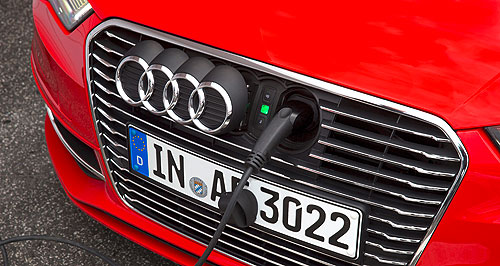Future models - Audi - A3 - e-tronAudi Australia moots more plug-in hybridsUnplugged: Audi Australia has expressed interest in e-tron versions of the next Q7 and A6/A8, but the as-yet unseen second-generation R8 version could also be an option. Circa $60k A3 e-tron due early 2015 as Audi Australia ponders which plug-ins follow9 May 2014 AUDI Australia managing director Andrew Doyle says the company will consider expanding its range of e-tron plug-in hybrid vehicles beyond the imminent A3 version, if and when they become available. Speaking with GoAuto at last week's Australian S8 product launch, Mr Doyle called a possible expansion of the e-tron family in Australia an “interesting proposition”. For now, the only confirmed Audi plug-in is the A3 Sportback e-tron available in Europe and due to hit a small number of Australian dealers in early 2015. However, global parent Audi AG is believed to be working on having e-tron versions of all its vehicles as soon as 2020, with a reborn R8 supercar version now in the works and a China-only A6 version premiered last month just the beginning. “I think we have to look at every case as it comes but I'm very confident about e-tron and if it's launched in large models such as one of the Q models (Q5 or Q7) or a larger sedan, I think it would be a very interesting proposition for Australian consumers,” Mr Doyle said. In an interview in Frankfurt last September, Audi board member for technical development Ulrich Hackenberg told us the company was focusing on “bridging technology” such as plug-in hybrids because it could take up to 10 years until batteries allowed regular EVs to have “normal mobility”. The A3 e-tron’s running gear consists of a 110kW 1.4-litre turbo petrol engine linked to a 75kW disc shaped electric motor via a special clutch. Power is sent to the front wheels via a newly designed six-speed ‘e’ S tronic dual-clutch automatic transmission. Total system output is 150kW of power and 350Nm of torque – nigh on hot hatch figures – while Audi claims the two power sources “complement” each other as the motor provides peak torque from start-up through to 2000rpm, by which time the petrol engine’s peak torque has arrived. The e-tron can be driven with just the petrol engine, as a pure electric or as a combination of both. When the driver lets up on the throttle, both sources de-activate temporarily. All this makes it similar in concept to the Holden Volt and the range-extender version of BMW's forthcoming i3 – due in November – but without the stand-alone styling. While it is a little early to lock away local pricing, Mr Doyle said he thought Audi could “do a little better” than the $69,990 BMW charges for its i3 range-extender (it costs $63,900 for the pure EV without the extra range), though perhaps not beat the $59,990 Volt starting price. “There will be a limited dealer network spread across Australia. You can probably guess where that may be,” Mr Doyle said. Using industry numbers as a guide, launching an electrified vehicle in Australia is a decision based on brand image rather than raw sales potential. The local market has experienced an exceedingly slow uptake of EVs and plug-ins thanks partially to a lack of industry incentivisation. Unlike many countries in Europe, Asia and parts of the US, notably California, Australia has no customer subsidy and very few legislative 'push' factors such as free tolls and registration to counteract the high showroom price of these high-tech vehicles. At present, the only pure EV on sale is the Nissan Leaf, while the Holden Volt and Mitsubishi Outlander PHEV are both plug-in hybrid vehicles that come with a supplementary petrol engine that charges the battery cells if they die before being recharged via the mains power grid.  Read more11th of April 2014  BMW i3 priced from $63,900BMW adds groundbreaking i3 to range in both full-EV and range-extender guise6th of March 2014  Audi’s e-tron electric supercar back on the radarTechnology breakthrough means Audi can again ponder an R8-based electric supercarA3 pricing
Motor industry news |
Click to shareAudi modelsA3 pricing
Motor industry news |





























Facebook Twitter Instagram